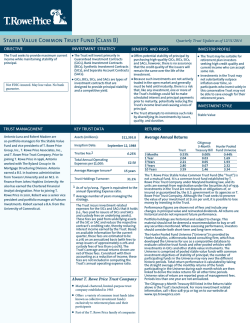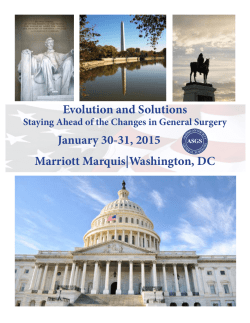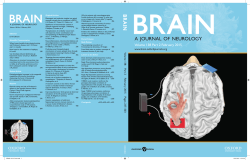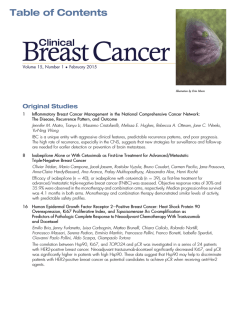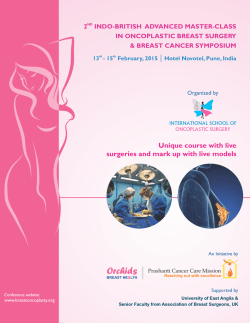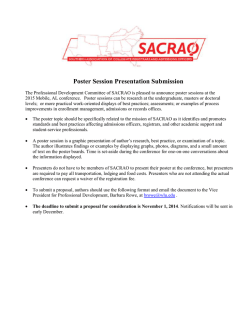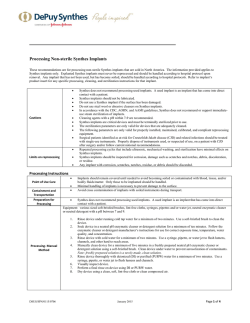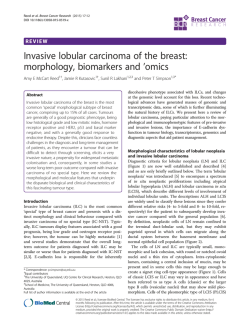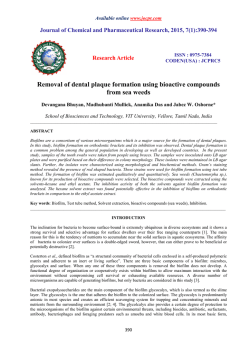
02feb15 Show Notes Dr Norman Rowe
02 February 2015 Inside Cosmetic Surgery Today on WebTalkRadio.net Interview with Dr Barry Lycka & Dr Norman Rowe Dr Barry Lycka cosmetic dermatologist from Edmonton, Alberta is talking today with Dr Norman Rowe board certified plastic surgeon from New York City’s Upper East Side Today we are going to talk about some very exciting new things happening in the world of breast surgery. Dr Rowe has been in the news about something called the Instabreast, and we are really intrigued about this. We have talked previously with Dr Rowe, and everyone loved that particular show – the link for it is at the end of these notes. But today we are talking about a new technique which will help a patient decide whether they really want a breast augmentation. What it is really going to look and feel like. It is a simple technique and does much more than taking pictures and modifying them, which doesn’t help the patient feel what the breast will be like. Welcome, Dr Rowe! Many women want to have a larger breast size BUT they are petrified because they don’t know what it is going to look like or feel like, and really don’t know what is going to happen either. What are your thoughts, Dr Rowe on fixing these problems? Well that is part of how Dr Rowe came up with the Instabreast. He only had a couple of ways to help someone who was interested in a breast augmentation to get an idea of what they would look like. Basically putting an implant in their bra, and also taking photographs and using photo enhancement programs to give them an idea. Both are OK and good methods but no technique was available to show them what they would look like actually in their body and more importantly, what the implant would feel like. So this is what Dr Rowe came up with the idea for Instabreast. He injects saline which gives the patient a good idea of what an implant it is going to look like but also what it may feel like inside their body. That is a ‘huge’ idea, whose time has come! Dr Lycka has always done something like this when a person wants to know what a filling substance may look like in their face. We can put saline in which gives the person the idea what it will look and feel like, and it lasts for a short period of time around 24 hours. Is that about the same idea that you have been thinking of, Dr Rowe? Yes exactly. Dr Rowe has also been injecting saline into the cheeks, nose, chin for someone who was contemplating either putting a temporary filler in or even for patients contemplating putting a permanent implant in their nose, chin etc., and so that is how he came up with the Instabreast – if it works for the face, would it work in the same way for a patient’s chest? And yes it does work beautifully. It’s a simple procedure which involves an injection of saline which is basically salt water which is found in our body anyway, and it is used routinely in medicine today. Anytime you need a little IV fluid that is what is given to you, so it is not a foreign substance and it can be injected to give the patient an idea of what they want. It also works well on other parts of the body too. Dr Rowe uses this idea on a variety of parts of the body when a patient is considering using an implant, including also for men in the pectoralis. So saline works as a type of ‘try it before you buy it’ technique. This is fascinating. Let’s suppose a person wants to go to a party tomorrow – would this be a technique to help them through the big event? Honestly – No. The reason is because Dr Rowe really didn’t design it for the person who wants to fill out their dress for a party. It was designed as a method to help inform a patient of what size they may want, what the implants are going to feel like, and also to help the surgeon determine what size implants a patient wants. So if someone is seriously considering breast implants, then they are offered the Instabreast. It will stay inflated for about 24 hours, and so if they did happen Inside Cosmetic Surgery Today interview Dr Barry Lycka and Dr Norman Rowe, 02feb15 1 to have a party of event that night then they would get the benefit of it. The majority of patients that Dr Rowe does Instabreast on, for one reason or another, have it done on a Friday, maybe because they will have their breasts for the Friday night but it really wasn’t designed for that. So if someone comes in saying that they have no interest in getting breast implants but wants Instabreast for a party that night, then Dr Rowe will not inject that patient. Excellent – Dr Lycka wanted to clarify that because the Press had given the impression that that is what it is for! Well the Press will spin a story to sell newspapers, but Instabreast wasn’t designed, or is used, for that. One of the most common comments that Dr Rowe hears from patients after their breast augmentation is ‘I should have gone bigger,’ so this is designed to help out with the ‘buyer’s remorse’ so that they know after trying out the 300 or 400 ccs of saline whether the size is perfectly Ok or they could go a bit bigger. That really clarifies, Dr Rowe, where a procedure like this fits with a person. It’s really hard, without a tool like this, to explain to people what it will feel like, so this will help us to help people make their decision. Yes, there are very few things that we do that we can show a patient to give them an idea of what they are going to experience at the end of a procedure, without actually doing the procedure. This is one that we can actually show them with pretty good certainty of what it is going to feel like and they can decide not to go ahead with the actual procedure. The patients that have gone to see Dr Rowe about having a breast augmentation, and opted for the Instabreast ‘try before you buy’, about 75% of them go ahead and do the surgery. But the more important number is the 25% that don’t. What that tells Dr Rowe is that 25% of patients he has helped in the past might have decided that it wasn’t for them and might not have found that out until after they had surgery and then regretted it afterwards. That is a very important thing, it’s a very important number. Both doctors spend a lot of time talking with their patients trying to explain what it is going to be like. They don’t like to have any dissatisfied customers at all, so it is very important to them to have a tool that can really help people see and feel this and be able to move further along with it. 25% of breast surgery patients, at least in Dr Rowe’s practice would have had no other way to discover if they liked it or not other than going ahead and doing the surgery. It is a very important tool as a method to an end – not the end. As doctors we have to always put ourselves into our consumers’ thoughts and space, and see where they are ‘coming from’. That is often a very hard thing for a doctor to do. This procedure allows people to do that. We always have to have the patients’ best interests in mind, whether they want it or not, if we think something will help them, or we think it will harm them, we have to tell them one way or the other. So if someone goes to see Dr Rowe asking for Instabreast but they are not interested in a breast augmentation, then as a doctor he has to say that it is not in their best interests, and give them the benefit of one’s experience. Dr Rowe has been doing this procedures for about 2 years, and he has had women go see him a couple of times for Instabreast and then not go back to continue the breast augmentation decision process, and if they come back for a third time, he says that after 2 injections they need to have made up their mind, and proceed or otherwise with the surgery. It is not a method to use just because they want to look different for an event. The problem with a breast implant is that it is a fairly traumatic procedure. Less so than it used to be 20 years ago, but it still has a little bit of morbidity, little bit of downtime, bruising, swelling, and complications that can happen. Are there some new thoughts going on as to how to improve a breast without the downtime or risk of an implant? If we go back to where breast implants all started from, the ultimate breast augmentation method is a shot. The roots of breast implants even before the 1950s, and the first implants that came out to the market in the mid 1960 – people augmented breast by injections of free silicone into the breasts. This isn’t done today, it’s not safe, but it was the way to go back then. But the ultimate way to augment a breast is not by putting a confined shell filled with something, but actually to inject with something. That is where the future of breast augmentation is, instead of making a cut and putting in a confined mass of something. Obviously the saline injection only lasts 24 hours. But there are other materials they are being worked on that might last a bit longer, or of course using patients own fat is a very promising method, and has already shown great results and patients are very happy with – if of course they have enough fat to harvest. The beautiful thing about an injection would be that you can do it almost instantly, and it’s going to be long lasting, if not permanent, and at the same time it is going to give a person a fair bit of control over the situation. A false foreign Inside Cosmetic Surgery Today interview Dr Barry Lycka and Dr Norman Rowe, 02feb15 2 body is not being put into the body, even though breast implants have come a long way, there is still the risk of rupturing and the effect of time where they get thinner. And obviously capsular contracture is a problem with implants too. Dr Rowe, for the benefit of our listeners, please explain capsular contracture. Good question. Any time you put a foreign material in the body, the body’s natural response is to form scar tissue around it, and so that includes breast implants, and with a breast implant that scar is called a capsule. 100% of patients who get breast implants get a capsule. A certain percentage get a thicker capsule, this can be anywhere between 2% to 7% or 12 % of patients, depending upon the literature you read and the implants used. This capsule is so thick that it actually makes the breast feel hard, distorts the look of the breast and in some cases cause pain. When it does occur it is a problem. And the only way to get rid of it is basically to go in there, cut the capsule out and we may or may not put the implant back in. And then there is always the risk, let’s say we cut the capsule out and put a new implant in, there is a chance that the capsule forms again, and will be even worse. That is often the case, second time around the capsule forms worse than the first time. Dr Lycka notes that everything that we do has consequences, everything that we don’t do has consequences, and that is the problem that that we are faced with as doctors in this wonderful field that we belong to. Some things we can prevent, and some things we can work with if they do occur, but others unfortunately occur and they are still a problem afterwards that we can’t always predict, and can’t always protect a person against them. The best that we can do is to try and minimize the chance of an adverse effect happening, and try and educate the patient on the chance of that happening. But as far as implants, we are taking a foreign material and putting it into a patient, and a certain percentage will have an outcome that they just don’t like. In addition to the capsular contracture that we have talked about, Dr Lycka has heard about a problem that occurs in a certain percentage of patients called bio-film where a person gets an infection from their own body when the implant is put in, of either a yeast or bacteria, or a combination of them, which can be long lasting as well. Some people think that the biofilm is what causes the capsule and we really can’t prevent the biofilm. Whenever you put a foreign material in the body, there is a layer of bacterial substance that just coats the implant, and it is always there from the time the implant or whatever is placed. The body naturally keeps that bacterial sheath in check, but if for any reason a person has a decrease in their immune response, then that biofilm can overwhelm the body’s natural defenses, and that is when illness can happen. It can happen in other places than when implants are used – for example when catheters are used. But biofilms are thought to play a role in creating that thickened capsular formation. Dr Lycka thinks that that is a very important point. A biofilm is a biological zoo where all these organisms are living together and causing a problem and a reaction in the tissue which causes more and more problems as time goes by. It is very hard to clear because there is a foreign body in the tissue, the body just doesn’t get rid of it that well. Dr Rowe comments that it doesn’t get rid of it but it does keep it in check. Numerous studies have shown at least with breast implants, that when they have removed the implants, and cultured that biofilm, it has come back as yes there is bacteria there but those patients didn’t have any clinical signs of infection. So it leads us to believe from that where they maybe a biofilm, it doesn’t play a role in a normal healthy person. It is only when a person becomes immune compromised, when the biofilm can maybe overwhelm the immune system and ‘flare up.’ Dr Rowe has had patients who have had breast implants and never had an issue, then they go to the dentist 5 years later, and get an infection and then all of a sudden they have infections around their breast implants. So not only is that biofilm an issue but systemic or blood borne spread of bacteria from one portion of the body to another is always an issue too. One of the ideas that Dr Lycka has been working on is a technique called SVELT, Small Volume Serial Elective Lipo Transfer. It can be done over and over again, and each time we are putting small volumes of fat back into the breast, and each transfer to each breast is about 100ccs. That seems to be the magic number where the complications are minimized – such as cysts, calcification – and has had very few complications when kept below that magic number. It is done under local anesthesia, the fat is harvested of course in a very specific sterile manner, and put back in, in a very nice plane, and the fat tends to take very well with almost 100% take rate which is very, very encouraging. And we can do this over and over again, rather akin to blowing up a balloon. Dr Lycka has been a co-developer of this with Dr Daryl Hoffman from Stanford California, and it is a very nice technique, and they have done several hundred cases between the two of them. It doesn’t give a huge augmentation because lots of people don’t have enough fat to give Inside Cosmetic Surgery Today interview Dr Barry Lycka and Dr Norman Rowe, 02feb15 3 to have a huge augmentation, but it certainly does something very nice for a lot of patients, such as people with small breasts wanting to go up a little bit, and as long as they have fat elsewhere on their body, then it is a real nice technique. What would your thoughts be on that Dr Rowe? The SVELT technique is a wonderful technique. As we said earlier, the ultimate breast augmentation technique is an injection that does the job, leaves no morbidity, no real downsides, and something that a patient can get done relatively easily, and safely, and using the patient’s own fat is a very good method to do that. Dr Rowe uses the technique if someone has implants and they get a little ‘rippling’ then using their own fat to ‘camouflage’ can be a good technique. Using up to 100ccs per side is a god technique and there are even people pushing that envelope a bit more and it seems that the volume that you instill is dependent upon the breast envelope. The more laxity that you have in the breast envelope, then the more fat can be instilled, is what the research is showing. For example if we have a 1 liter balloon and we are trying to fill it with 2 liters then everything will be tight. If you have a 1 liter balloon and inject 1 liter then everything will be nice and loose. So fat graft survival is depending upon 100% take and so many people are being too aggressive and trying to cram too much into the breast and the fat just doesn’t survive. So you either have to pre-expand the breast envelope or, as Dr Lycka does, do it in repeated smaller volumes so it takes better. Which means the fat survives where it was injected, rather than coming back 6 months later and starting again. Well then they are even worse off because then they have scar tissue which makes a worse situation, and it makes it more difficult for mammograms too. So if we keep the volume down and prevent all the problems, its better. Personally, Dr Lycka always does a pre-operative mammogram so there is a baseline so that if things do start to change, then they always know exactly what was done. It is a good technique, something that people should think about. The beautiful thing about it is that it doesn’t require general anesthesia. It is a huge advantage and not only is it showing promise for breast augmentation, but using a patient’s own fat is now routinely taking over in other areas where implants have traditionally been used, such as buttock augmentations. Ten or 15 years ago the vast majority of buttock augmentations were actually done with implants but the tables have now turned and the vast majority of them are being done with the patient’s own tissue and the minority of them being done with implants. Are there any parting words that you want to expand upon Dr Rowe on the Instabreast procedure that you are working on – perhaps to use something longer lasting? First of all thank you once again for having me on the show, it is always a pleasure! And that the show imparts knowledge and help to the listeners. And if listeners do have any questions then then can contact Dr Rowe – he is in New York, and he does the Instabreast routinely for someone who is considering a breast augmentation, as a ‘try it before you buy it’ and down the road, the next step for this is to get it to last a little bit longer than the saline does at around 24hrs. Dr Rowe is in the early developmental phase of an injectable that will last substantially longer than that and Dr Rowe is very excited and hopefully in the future when that comes about, we can talk about that as well. That would be wonderful, Dr Rowe! This show is about the newest advances in cosmetic surgery and you certainly have a lot of good ideas, and this is where the scope of things is going. We are getting gentler procedures, lasting longer, less traumatic, patients can try things out for look and feel before they go ahead, and it really is a different world now than it was several years ago. It is patient driven and patients want more for less – they want more and more results and less and less downtime. Contact details for Dr Norman Rowe & Dr Barry Lycka: Dr Norman Rowe Telephone: New York: (212) 628 7300 http://www.normanrowemd.com/ Previous show with Dr Rowe: http://webtalkradio.net/internet-talk-radio/2014/10/20/inside-cosmetic-surgery-today-preventing-reducingcorrecting-scars-after-surgery-dr-lycka-dr-rowe/ Dr Barry Lycka Telephone: Edmonton: (780) 665 3546 http://www.barrylyckamd.com Inside Cosmetic Surgery Today interview Dr Barry Lycka and Dr Norman Rowe, 02feb15 4
© Copyright 2026
